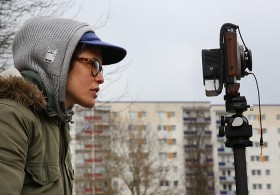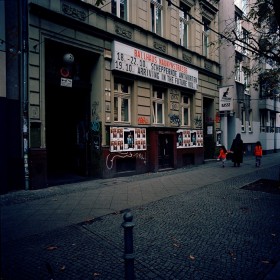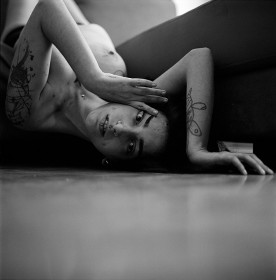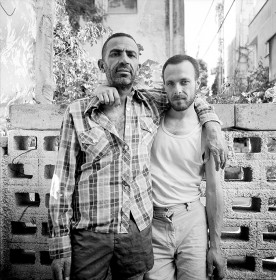History cannot be captured in a single form. Not in brass, not in metal. That is what Hadas Tapouchi says. The Berlin-based Israeli artist believes that monuments and inscriptions miss the actual sense of commemoration. This type of remembrance would be an inevitable path towards forgetting.
Undoubtedly, Hadas works against forgetting. Upon our first meeting at her Tel Aviv apartment about four years ago, the artist’s rendered self-portrait in prisoner’s garb immediately jumped out at me. It was one of the precursors to her project, “The Third Generation“. A countless number of portraits since followed – portraits of mutual friends, the author himself, as well as young men and women between Berlin, Tel Aviv and Ramallah.
Until today, Hadas’s high demand for memory is palpable in her work. Her earliest series, “Transforming”, focuses on NS forced labor in and around Berlin. There, along with the project’s supplementary website, she exposes an uncanny tension between the presence and absence of history. However, she does not want this work to be compared to Gunter Demnig’s well-known Stolperstein (stumbling stones) project. “This isn’t about a single stone!” she answered me recently, in fiery English and with raised arms, at a joint event (in the Berlin gallery, Werkraum Bild & Sinn). This seems to be her main concern, the general focus of her work: Hadas wants nothing less than to change the very way we view the present as well as the future.
The foundation of this approach is instilled in “The Third Generation”. Instead of static commemoration, she puts faces in the foreground. “The two works complement each other,” Hadas explained on the same evening. Further, it would be important to regard them as one. However, “The Third Generation” is far from completion. Tapouchi sees it as a “work in progress”.
Both projects begin with Hadas’s own biography. Her grandmother, a Shoah survivor from Poland, gave little account of those years. The shadow of this experience spread over the artist’s mother like a lead blanket. From an early age, Hadas understood her role as a representative of the third generation of victims of the Shoah.
The realization that there could also be a third generation in Germany – those of her age, affected by a similar type of silence about the past – didn’t occur to her until later. Then she began photographing people in Berlin about six years ago. “I was curious if the people there even saw themselves as a third generation,” she recalled. She’s yet to find a clear answer to that question. The intense pull between young Germans and Israelis today is an indication for two generation’s bonds that can be extended to young Palestinians – those in Israel as well as in their Diaspora – too, Hadas says.
That those portrayed appear strangely familiar is what allows those contrasting histories to be assembled into a single collage. Clearly, the unifying factor is sexuality – that is, queer sexuality, which extends beyond the (hetero)norm. “The community I focus on in ‘The Third Generation’ is influenced foremost by the queer community.”
The historical background – the Shoah as it affects descendants of its victims and perpetrators, as well as the Nakba (the Arabic word for “catastrophe”, used for the Palestinian displacement at the time of the Israeli independence war) – is amended by personal histories and thereby undermines rigid narratives. “The camera’s changing resolution allows me to bring out their similarities rather than their differences,” Hadas explains.
No doubt this is a controversial approach. If one wanted to describe the status quo of Israel’s commemoration policy in two words, it would be, “Al Tisch’we!” (don’t compare). In other words, the Shoah cannot be compared to any other historical event.
“I hear this criticism all the time,” Tapouchi complains. “But I was never after a strict comparison!” Rather, her goal was to present what Israelis, Palestinians and Germans in the Third Generation have in common. Nevertheless, this strikes many as a radical statement. In Israel, Hadas says with a hint of resignation, commemoration first and foremost serves the national consciousness. Most people simply would not think.
It’s an observation that could probably, to a certain degree, be applied to Germany, as well. Certainly, “The Third Generation” targets sensitive questions: What exactly does “remembrance” mean 70 years after the Shoah, and nearly 70 years after the foundation of the State of Israel and the Federal Republic of Germany? Who remembers and out of which motivation? How does remembrance change over time? Which forms of remembrance are allowed? Which are forbidden?
Today, Hadas is primarily eager to see how “The Third Generation” will develop. Sometimes she wonders if, 10 or 20 years from now, her project might seem ridiculous, even cliché. Or, on the contrary, if it might lead the way to a new type of commemoration. She is curious how the Shoah’s fourth generation will react, or the fifth; the series won’t lose its relevance anytime soon. That much is certain.
Hanno Hauenstein is a journalist, writer and curator of “Hoffnung auf Grenzen / Grenzen der Hoffnung” (Hope on the border/borders of hope), where Hadas Tapouchi’s “The Third Generation” was first exhibited in Germany.
PS: Hadas Tapouchi’s photos from her portrait series, “The Third Generation”, have been available for purchase from the permanent exhibition’s art vending machine since the beginning of April.
Further information about the artwork and the other artists of the art vending machine can be found here.



